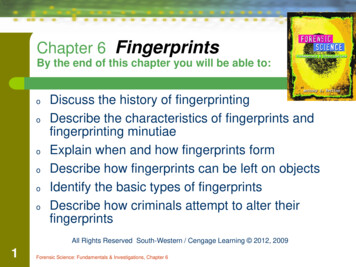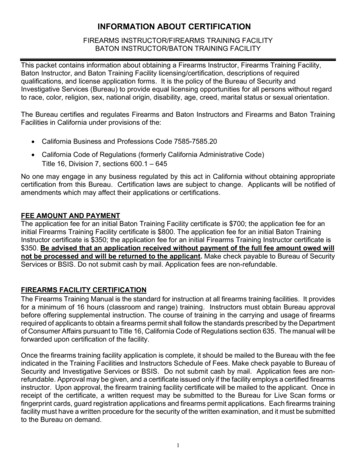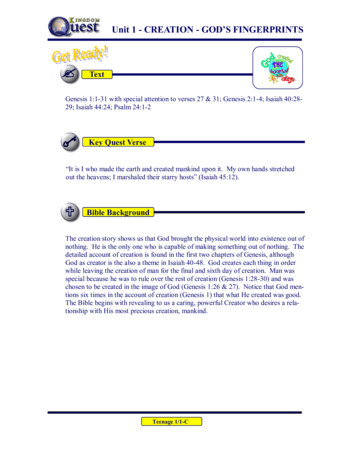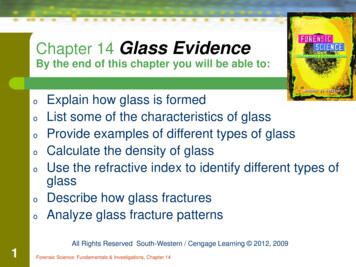
Transcription
Chapter 6 FingerprintsBy the end of this chapter you will be able to:ooooooDiscuss the history of fingerprintingDescribe the characteristics of fingerprints andfingerprinting minutiaeExplain when and how fingerprints formDescribe how fingerprints can be left on objectsIdentify the basic types of fingerprintsDescribe how criminals attempt to alter theirfingerprintsAll Rights Reserved South-Western / Cengage Learning 2012, 20091Forensic Science: Fundamentals & Investigations, Chapter 6
Chapter 6 FingerprintsBy the end of this chapter you will be able to:oooooo2Determine the reliability of fingerprints as ameans of identificationDescribe the Integrated Automated FingerprintIdentification System (IFAIS)Explain how fingerprint evidence is collectedDescribe the latest identification technologiesDetermine if a fingerprint matches a fingerprint onrecordUse the process of lifting a latent printForensic Science: Fundamentals & Investigations, Chapter 6
Historical Development31.3rd century B.C. in China—oldest knowndocuments2.Ancient Babylon (1792-1750 B.C.)—fingerprintspressed into clay tablets marked contracts3.1684—Dr. Nehemiah’s paper describes the patternson human hands, including the presence of ridges4.1788—Johann Mayer noted that the arrangement ofskin ridges is never duplicated in two personsForensic Science: Fundamentals & Investigations, Chapter 6
Historical Development5. 1823—Jan Evangelist Purkyn describes ninefingerprint patterns6. 1856—Sir William Herschel (right) began thecollection of fingerprints and noted they werenot altered by age7. 1883—Alphonse Bertillon created a way toidentify criminals that were repeat offenders4Forensic Science: Fundamentals & Investigations, Chapter 6
Historical Development8. 1888—Sir Francis Galton (r) and Sir EdmundRichard Henry developed the fingerprintclassification system still used in the US9. 1891—Iván (Juan) Vucetich collected all tenfingerprint impressions and noted measurements10. 1896—Sir Henry, with two colleagues, created asystem that divided fingerprints into groups. All tenfingerprints are imprinted on a card (called a tencard) along with other notations5Forensic Science: Fundamentals & Investigations, Chapter 6
Example of a Ten Card6Forensic Science: Fundamentals & Investigations, Chapter 6
What Are Fingerprints?ooooo7All fingers, toes, feet, and palms are coveredin small ridgesRidges help us grip objectsRidges are arranged in connected units calleddermal, or friction, ridgesFingers accumulate natural secretions and dirtFingers leave create prints on objects wetouchForensic Science: Fundamentals & Investigations, Chapter 6
Structure of Skin8Forensic Science: Fundamentals & Investigations, Chapter 6
Formation of FingerprintsoSkin consists of: ooo9Inner layer—dermisOuter layer—epidermisBasal layer in betweenBasal layer grows faster than the layers above andbelow itBasal layer collapses and folds to form intricateshapesFingerprints begin forming near the 10th week ofpregnancyForensic Science: Fundamentals & Investigations, Chapter 6
Characteristics of FingerprintsoThere are 3 general fingerprint distinctions:ARCHWHORLLOOPAbout 5%About 30%About 65%of the population10Forensic Science: Fundamentals & Investigations, Chapter 6
Characteristics of FingerprintsoForensic examiners look for oRidge count 11Core(the center of a whorl or loop)Deltas(triangular regions near a loop)Counting from the core to theedge of the deltaDistinguishes one fingerprintfrom anotherForensic Science: Fundamentals & Investigations, Chapter 6
Characteristics of Fingerprints12Forensic Science: Fundamentals & Investigations, Chapter 6
Characteristics of Fingerprints13Forensic Science: Fundamentals & Investigations, Chapter 6
Characteristics of FingerprintsoBasic patterns can be further divided: Arch patterns: 4% plain 1% tented Whorl patterns: 2% central pocket 4% double loop 0.01% accidentalo14Even twins have unique fingerprintsForensic Science: Fundamentals & Investigations, Chapter 6
Fingerprint Minutiae Patterns15Forensic Science: Fundamentals & Investigations, Chapter 6
Types of FingerprintsThere are 3 types of prints that investigatorslook for at crime scenes:1. Patent fingerprints—visible prints transferredonto smooth surfaces by blood or other liquids2. Plastic fingerprints—indentations left in softmaterials such as clay or wax3. Latent fingerprints—made visible by dustingwith powders or the use of chemicals16Forensic Science: Fundamentals & Investigations, Chapter 6
Fingerprint Forensic FAQso17How are latent fingerprints collected?Forensic Science: Fundamentals & Investigations, Chapter 6
Fingerprint Forensic FAQsoCan fingerprints be erased?Only temporarily; they will grow back if removed with chemicalsoIs fingerprint identification reliable?Yes, but analysts can make mistakesoCan computers perform matches in seconds?No, but the FBI’s Integrated Automated Fingerprint IdentificationSystem (IAFIS or AFIS) can provide a match in 2 hours18Forensic Science: Fundamentals & Investigations, Chapter 6
The Future of FingerprintingoNew scanning technologies Yield detail in minute patterns Reduce analytical mistakesAnalyze trace elements of objects on the skin oTechnologies that recognize patterns in 19RetinaFaceVeins in your palmForensic Science: Fundamentals & Investigations, Chapter 6
. . . . . . . . . . . . . . Summary . . . .ooo20Fingerprints have long been used foridentification, and in the mid-1800s wererecognized as unique to each person.Three main groups include arches, whorls,and loops.Basic analysis includes looking for cores anddeltas and making a ridge count.Forensic Science: Fundamentals & Investigations, Chapter 6
. . . . . . . . . . . . . . . . . Summaryooo21Investigators search for patent, plastic, andlatent prints.Dusting with powders or using specialchemicals can make latent fingerprints visible.New developments may eliminate errors byanalysts.Forensic Science: Fundamentals & Investigations, Chapter 6
1 Forensic Science: Fundamentals & Investigations, Chapter 6 Chapter 6 Fingerprints By the end of this chapter you will be able to: o Discuss the history of fingerprinting o Describe the characteristics of fingerprints and fingerprinting minutiae o Explain when and how fingerprints form o Describe how fingerprints can be left on objects o Identify the basic types of fingerprints










